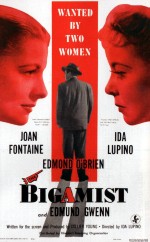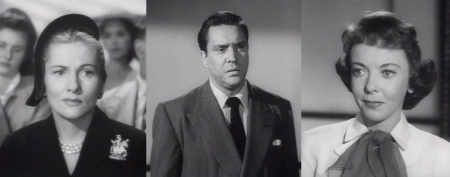Women's Pictures - Ida Lupino's The Bigamist
 Thursday, March 19, 2015 at 3:00PM
Thursday, March 19, 2015 at 3:00PM
 Joan Fontaine was married to Ida Lupino’s husband. That is both the plot of Ida Lupino’s melodrama The Bigamist and the truth of the two stars’ relationship in 1953. Of course, Lupino had already divorced her writing partner and co-producer Collier Young when he married Fontaine in 1952. All three remained friends, and Young maintained his professional relationship with Lupino, even writing The Bigamist for his ex-and-current wives to star in. Unfortunately for the gossip mongers, there’s very little drama in the behind-the-scenes story of The Bigamist, but that’s probably for the best, because the movie is practically drowning in drama.
Joan Fontaine was married to Ida Lupino’s husband. That is both the plot of Ida Lupino’s melodrama The Bigamist and the truth of the two stars’ relationship in 1953. Of course, Lupino had already divorced her writing partner and co-producer Collier Young when he married Fontaine in 1952. All three remained friends, and Young maintained his professional relationship with Lupino, even writing The Bigamist for his ex-and-current wives to star in. Unfortunately for the gossip mongers, there’s very little drama in the behind-the-scenes story of The Bigamist, but that’s probably for the best, because the movie is practically drowning in drama.
The Bigamist is relatively straightforward story of how one man ends up with two wives. Though it preys on the possible unspoken fears of a stay-at-home wife – What if my husband sees another woman when he says he’s at work? What if his ‘business trips’ are to spend time with her? –The Bigamist does not qualify as a Women’s Picture. On the contrary, it’s told from the polygamist protagonist’s point of view.
The story is related mostly in flashback as traveling salesman Harry Graham (Edmund O’Brien again) explains to an adoption agency worker (Edmund Gwenn, aka Santa Claus!) how he was trapped into two marriages by his middle class morality and sense of duty. Poor Harry loves his career woman wife, Eve (Fontaine), though she is distant, and communicates only over breakfast tables or telephones. He finds comfort with a waitress named Phyllis (Lupino), and decides to do the honorable thing when she discovers she’s in the family way. As the judge explains at the end (melodramas use courtrooms so a judge can tell the audience the moral of the film), Harry is not a bad man. Just a confused one.

(Side note: It’s possible that I’ve been watching too much Empire, but I spent all movie waiting for Ida and Joan's characters to discover each other’s existence and claw each other’s eyes out. I was disappointed.)
Though she isn’t credited as screenwriter, Lupino still did triple duty, producing, directing, and starring in her morality melodrama. This was possibly the best cast she ever assembled (thank Fontaine's waning career), and they do an admirable job with a heavy handed script. Being director/producer, she gave herself the better role: the second wife/main love story. That leaves Fontaine breathing life into the mostly cold character of the first wife. O'Brien, around whom the film turns, plays a surprisingly strong romantic lead for this film. He's alternately guilty, charming, and pitiable. The film is shot in Lupino’s customary “realistic,” on-location style, with more noir stylistic flourishes learned from The Hitch-Hiker. Unfortunately, despite its moments, the movie's message doesn’t land.

The problem may be the handling of the subject matter. The film works very hard to explain and empathize with Harry Graham, turning his affair with the waitress into a tragic love story. It’s a surprisingly humanist take on crime (especially this crime), but also an unintentionally trivial one. There’s a sharp disconnect between the deadly serious way bigamy is discussed, and the actual fallout of Harry’s actions: a possible short jail sentence, the temporary bastardization of his son, and two disappointed ex-wives. Folks on Maury get worse.
The Bigamist, like so many of The Filmmakers’ movies, discusses a subject that was verboten in postwar America. But to what end was this movie made? Lupino had such a clear direction for her previous films - illuminating polio procedures, tackling rape, unveiling crime. Bigamy, by contrast, seems ridiculous, despite the serious way the judge preaches about it at the end of the film. While the judge briefly picks at an interesting thread about the double standards of shameful bigamy vs societally tolerated mistresses, it's dropped and quickly forgotten. For the first time, the cinematic crusade of Ida Lupino and The Filmmakers feel fairly flat.

Unfortunately, this would be Lupino’s last directing project for her production company. Her next big screen directing gig was also her final film, thirteen years later. And it was... a comedy?

3/26 - The Trouble With Angels (1966) - Lupino's last feature film involves Rosalind Russell, Hayley Mills, and nuns. (Available on Amazon Prime)



Reader Comments (10)
I watched this in my Women & Film class in college and really enjoyed it. I had never seen an Ida Lupino directorial effort (I had seen her acting) and was impressed by her handling of the characters and their ability to garner sympathy, especially Harry. I remember the majority of the class being very sympathetic toward him in the end, which isn't what the professor quite expected. I mean, almost everyone agreed that his actions were wrong, but couldn't deny feeling terrible for everyone involved. I think we also went into a brief spell about bigamy and the law, but that's a much longer argument...
Reading these write-ups makes me want to find a good Ida Lupino biography and read about her life between 1949 and 1968 when she was directing for film and television. Anyone know if the Donati (2000) is any good?
That is a great poster.
While it's no Hitch-Hiker this is a solid film and all three stars acquit themselves well. I'm not the biggest Fontaine fan but she does well by her role.
I think this is the only time Ida directed herself, even in her TV work. Would love to know why, did the opportunity just never present itself again or was it too distracting on top of her other duties. Edmond O'Brien must have liked her directing style coming back for a second go round.
Anxious to read your thoughts on The Trouble with Angels next week, love that movie.
@Keelay!: Me too! I first saw this in a women in film course and we all enjoyed the film. But we found the message of the film somewhat strange. Adultery was wrong unless you get your mistress pregnant and marry her. Then you become a decent guy caught in a bind.
And the legal system is not helpful, because sending him to jail doesn't solve anything.
I don't know of a good biography for Lupino, but she strikes me as a person who was interested and able to look at any situation and get past the surface and find out what was really going on. Nowadays she would make a good director for "The Good Wife" or "Empire" or OITNB.
Paul Outlaw - I'm using the Donati biography as one of my resources this month. It's not bad! It verges on hagiography occasionally, but it does spend a good chunk of time on her directing career, which I appreciate. It's an easy read. I'd check it out!
So I think the generational piece is missing here. Men could be men and have affairs (wink wink) “Women’s Pictures” are full of this and the wronged woman. What makes this story line unique was the addition of a child. A child born out of wedlock was a very big deal back them. I can’t tell you how much except to say perhaps that my grandmother used to point out that my dad was born 10 months after her marriage…not eight. Even in the 60’s gossips used to count on their fingers when a baby was born the first year of a marriage.
It does seem odd today when people have children first and marry later. So the reason this picture was unusual, was that Edmund Obrien was trying to do the right thing. It is a realistic treatment of a very real mess that could happen in the context of post war morality.
Thanks, Anne Marie!
Leslir19 - good point about the historical context. The film does put a lot of emphasis on children, and on Harry's desire to "do the right thing." I guess that particular stigma has been lost.
Leslie19 has a good point. I know a man who's parents told him he was a Leo (which would have placed his birth 10 months past their wedding) when in reality he was a Gemini (born 7 months post nuptials). As he was into astrology, you can imagine how upset he was when he found out the truth (after the death of his parents and going through their papers). A child born out of wedlock was such a huge deal. The woman would be ruined socially, the child branded for life, even if the parents married before the birth. A shotgun wedding was never forgotten. During the time this film was made, very much a man's world, the man taking responsibility for his actions would be seen as admirable, even if he caused the problem in the first place (more of less).